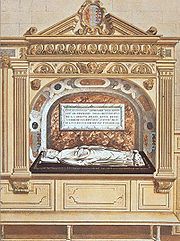
Couvent des Célestins
Encyclopedia

English language
English is a West Germanic language that arose in the Anglo-Saxon kingdoms of England and spread into what was to become south-east Scotland under the influence of the Anglian medieval kingdom of Northumbria...
: Convent of the Celestines
Celestines
Celestines are a Roman Catholic monastic order, a branch of the Benedictines, founded in 1244. At the foundation of the new rule, they were called Hermits of St Damiano, or Moronites , and did not assume the appellation of Celestines until after the election of their founder to the Papacy as...
), was an ancient convent
Convent
A convent is either a community of priests, religious brothers, religious sisters, or nuns, or the building used by the community, particularly in the Roman Catholic Church and in the Anglican Communion...
located near the Place de la Bastille
Place de la Bastille
The Place de la Bastille is a square in Paris, where the Bastille prison stood until the 'Storming of the Bastille' and its subsequent physical destruction between 14 July 1789 and 14 July 1790 during the French Revolution; no vestige of it remains....
in Paris
Paris
Paris is the capital and largest city in France, situated on the river Seine, in northern France, at the heart of the Île-de-France region...
, France
France
The French Republic , The French Republic , The French Republic , (commonly known as France , is a unitary semi-presidential republic in Western Europe with several overseas territories and islands located on other continents and in the Indian, Pacific, and Atlantic oceans. Metropolitan France...
.
It was the second most important burial site for royalty after the Basilique Saint-Denis. The prestigious convent was located nearby Hôtel Saint-Pol
Hôtel Saint-Pol
The hôtel Saint-Pol was a royal residence begun in 1361 by Charles V of France on the ruins of a building constructed by Louis IX. It was used by Charles V and Charles VI.- Description :...
, the favourite residence of Charles V
Charles V of France
Charles V , called the Wise, was King of France from 1364 to his death in 1380 and a member of the House of Valois...
and Charles VI
Charles VI of France
Charles VI , called the Beloved and the Mad , was the King of France from 1380 to 1422, as a member of the House of Valois. His bouts with madness, which seem to have begun in 1392, led to quarrels among the French royal family, which were exploited by the neighbouring powers of England and Burgundy...
in the area of the Marais
Le Marais
Le Marais is a historic district in Paris, France. Long the aristocratic district of Paris, it hosts many outstanding buildings of historic and architectural importance...
. Many of the high-ranking princes from their court were buried in the convent.
However the convent was profanated during the French Revolution
French Revolution
The French Revolution , sometimes distinguished as the 'Great French Revolution' , was a period of radical social and political upheaval in France and Europe. The absolute monarchy that had ruled France for centuries collapsed in three years...
. After the revolution, some of the tombstones were recovered by Alexandre Lenoir
Alexandre Lenoir
Marie Alexandre Lenoir was a French archaeologist. Self-taught and devoted to saving France's historic monuments, sculptures and tombs from the ravages of the French Revolution, notably those of Saint-Denis and Sainte-Geneviève.- Life :The ravages of the Revolution caused the birth of the Musée...
. In particular the tombstone of the Latin king Leon V of Armenia was placed it in his Musée des monuments Français in the Saint-Denis Basilica.

